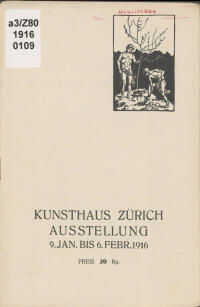Neue Münchener Sezession, «Walze»
09.01.1916 – 06.02.1916
Location Kunsthaus.
Location Kunsthaus.
“New Artistic Territory for Zurich
The association “New Munich Secession” was joined mainly by Expressionist artists and those of the New Objectivity. It was called into life in 1913 by artists who found that they were no longer well represented by the former “Munich Secession,” founded in 1892. From 1914 they presented exhibitions. In 1937, however, the New Munich Secession was dissolved by the National Socialists.
In 1916 for the first time, the Kunsthaus provided the Secession with a platform and presented about 75 paintings and sculptures as well as some 40 works on paper (“pen works”) by 33 artists, most of whom worked in Munich or Berlin and were under forty years of age. They included well-known artists like Paul Klee, Karl Hofer and Wilhelm Lehmbruck. The exhibition was supplemented with six artists of the Swiss group “Walze. Vereinigung Schweizer Künstler-Graphiker.” They exhibited etchings, woodcuts, and lithographs. According to a publication from 1918, This Swiss group included about 60 artists and held sales exhibitions in Zurich and Geneva in 1920.
According to the Zürcher Theater-Konzert-Freundschaftsblatt, the Zurich public already knew Karl Hofer (1878–1955) and Albert Weisgerber (1878–1915), who died in the war, as well as Robert Genin (1884–1941), Karl Caspar (1879–1956), his wife Maria Caspar-Filser (1878–1968), Rudolf Sieck (1877–1957), the Basler Alfred Heinrich Pellegrini (1881–1958) and Paul Klee (1879–1940). The NZZ described the Munich association as having “close connections with Expressionism” so that they were opening up new territory to the Zurich public which was exciting and serious. The German group was said to have “solid skills” and “an independent concept of art” (Zürcher Theater-Konzert-Freundschaftsblatt). The participation of the Swiss Walze artists was usually only briefly noticed, but “the power, simplicity and honest ability” of these artists were praised (NZZ). In the Zürcher Wochenschau it weas remarked skeptically that art associations usually attracted artists “of the second or third rank,” Even so, this exhibition was well informed about the current state of the art”.
[Peter Stohler]
Further information
The NZZ described the Munich association as having “close connections with Expressionism” so that they were opening up new territory to the Zurich public which was exciting and serious.
28 days
40 Artists
40 Artists

exhibition catalog